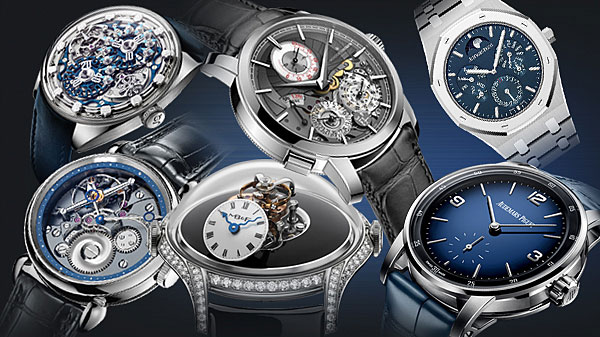
Second Prizes: Worthy winning timepieces from this year’s Grand Prix d’Horlogerie de Geneve
Every year, pretty much anyone with a senior enough role in keeping the global watchmaking sector ticking over descends upon Geneva for the ever-illustrious Grand Prix d’Horlogerie de Geneve (GPHG) awards. Founded in 2001 and now one of team timepiece’s preeminent tournaments, it sees the world’s leading haute horology houses all keenly competing to be crowned as creators of the most finely-crafted, most ambitious and most high-tech bit of haute horology of the year.
For the 2019 event, a bumper crop of 84 high-end chronograms went before a 30-strong jury of the wisest of watchmen, who were then tasked with winkling out the winners in each of the 18 keenly-contested categories. Of the timepieces triumphant, six stood out as particularly meriting top horological honours…
Aiguille D’Or Grand Prix

The preeminent performer at this year’s event was undoubtedly Audemars Piguet’s Royal Oak Selfwinding Perpetual Calendar Ultra-Thin. The world’s thinnest perpetual calendar watch, its movement has a depth of just 2.89mm, a cunning bit of compression brought to be by merging the three traditional layers of the perpetual calendar mechanism into just one component. This marvel of precision engineering even required the devisement of two new bits of tech – both subsequently patented – an end-of-the-month cam integrated into the date wheel and a combination month wheel / cam. Indeed, it would be hard to think of a worthier winner of the Aiguille d’Or Grand Prix, the competition’s highest honour,
Innovation Prize

Another award-winner – and another to feature a perpetual calendar complication – was Swiss marque Vacheron Constantin, with its Traditionelle Twin Beat Perpetual Calendar rightfully winning GPHG’s Innovation Prize. Blending formidable aesthetic appeal with remarkable functionality, its flexibility is its greatest asset. In active use, its Calibre 3610 QP movement oscillates at a singularly high frequency, driving the hour, minute, date, month and leap year cycle indicators with outstanding precision. Off-wrist, it powers down, extending its power reserve to at least 65 days.
Ladies’ Complication Watch Prize

Avant-garde maison MB&F’s first-ever ladies’ watch – the Legacy Machine FlyingT – soared straight to the top this year, clinching the Ladies’ Complication Watch Prize on its maiden outing. Its accentuated crystal dome and dazzlingly diamond-studded fascia have been cunningly designed to ensure its movement and its centrally-mounted flying tourbillon are ably highlighted. Its subsidiary dial, meanwhile, nestles against this array at an unusual 50-degree angle, ensuring the ensemble remains quirky yet undeniably chic. Overall, it’s a design classic and a true statement timepiece for any avid collector of femininely-fashioned timepieces,
Men’s Complication Watch Prize

Audemars Piguet returned to the fray and secured a second accolade with its Code 11.59 by Audemars Piguet Minute Repeater Supersonnerie winning hands down in the Men’s Complication Watch Prize category. Despite its stunning blue-on-white gold motif, it still remains remarkably minimalist in style. Underneath its smoked-blue enamel dial, however, its manual-winding movement is the height of mechanical sophistication, partly on account of its subtle incorporation of cutting-edge minute repeater supersonnerie technology – an innovation that notably amplifies its signature chime. In addition, its outer caseback has even been tactically perforated in order to admirably enhance its acoustics.
Men’s Watch Prize

In the case of the Finnish watchmaker Kari Voutilainen, its 28ti timepiece certainly had the wow factor as far as the GPHG jury were concerned. Attention-grabbing pretty much to the max, the ‘ti’ in its epithet stands for ‘titanium inverse’, a reference to both its premium case material and the fact that its handmade movement has been inversely fitted to allow direct viewing through its transparent caseback. Beautifully skeletonised, its front fascia has also been expertly optimised, with showcasing the watch’s elegant inner workings clearly a priority. Crafted wholly in-house, its elegance and technological prowess made it popular winner of the Men’s Watch Prize.
Mechanical Exception Watch Prize

The first production chronogram from Swiss marque Genus – the GNS1.2, winner of the Mechanical Exception Watch Prize at this year’s GPHG – proved a true revelation in the art of contemporary watchmaking, one that highlighted the intrinsic relationship between form and function – albeit with a decidedly outré twist. With its traditional hour markers set on a rotating ring, with an hour indicator fitted at 9 O’clock, it also features two minute rings, artfully connected by a serpentine chain that embraces them in that ever-lucky figure-of-eight pattern. Limited to a release of – unsurprisingly – eight pieces, the GNS1.2 ably blends traditional watchmaking conventions with a wholly contemporary appeal, making it – as with the other rightfully-celebrated timepieces – a truly worthy winner.
Text: Tenzing Thondup







